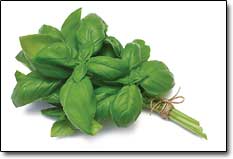The blend of aromatic essential oils that gives fresh basil leaves their warm and sweet odor is well characterized, but not much is known about the enzymatic machinery that manufactures the fragrant mix.
Researchers at U-M and the Salk Institute for Biological Studies in La Jolla, Calif., followed their noses and solved part of the molecular puzzle.

Their study, published in the Oct. 4 issue of the journal PLoS ONE, provides a three-dimensional snapshot of the enzyme basil eugenol synthase frozen in mid-action as it produces eugenol, the molecule responsible for basil’s spicy overtones reminiscent of cloves and cinnamon.
The reaction catalyzed by basil eugenol synthase is one that cannot be easily duplicated by chemists, says Eran Pichersky, professor of molecular, cellular and developmental biology. The research group was able to identify the mechanism of the reaction because they succeeded in studying the enzyme together with an analog of the substrate (the precursor compound that the enzyme converts into eugenol), something that had not previously been done with this class of enzymes.
Eugenol synthase belongs to a large family of enzymes that typically perform basic oxidation/reduction reactions in the cells (such reactions are involved in energy generation). But through natural selection, it has acquired a novel, additional function, says Joseph Noel, a Howard Hughes Investigator at the Salk Institute.
“This enzyme takes a basic building block that is usually employed to make wood and turns it into something that is almost the complete opposite of wood — a volatile molecule that easily becomes airborne, is highly aromatic and possesses antimicrobial and pain-dulling properties,” he says.
Such volatile molecules play vital roles in the lives of plants, enticing pollinators and fending off pathogens and leaf-eating animals. Plant biologists are fascinated with these plant chemicals, not only because of the scientific challenges they present, but because of their importance to human health and well-being.
The food-preserving and analgesic properties of eugenol-rich cloves lured explorers like Ferdinand Magellan and Christopher Columbus across the seas in search of new routes to the Far East, which was, at the time, the sole source of cloves. Although Columbus never reached India, he did discover the Americas and, incidentally, found the source for a new spice, allspice, which contains the closely related chemical isoeugenol.
The next step for Pichersky, Noel and their research teams will be to compare eugenol synthases and closely related synthases that make natural chemicals similar to eugenol from a wide variety of plants. Understanding the biosynthetic pathways used by plants to make all of these secondary metabolites may help researchers improve the flavor and nutritional quality of plants.
Researchers who also contributed to this study include U-M postdoctoral fellow Takao Koeduka and lab manager Marianne Bowman, graduate student John Taylor and undergraduate student Snejina Spassova, all of the Salk Institute.

